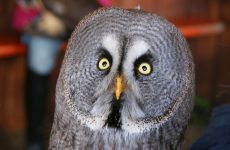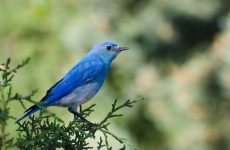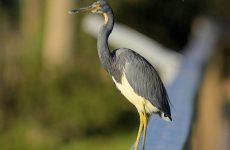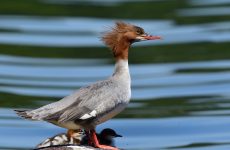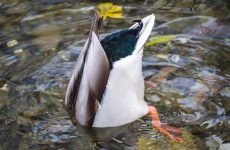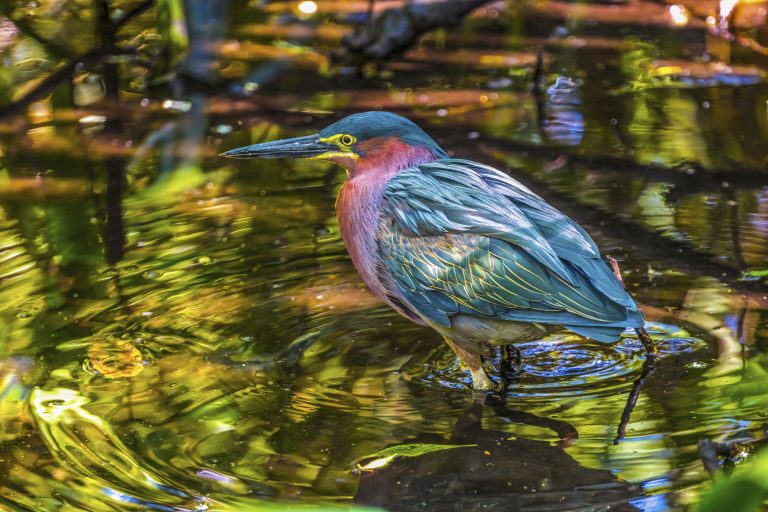
There are many green birds in North America, especially in spring and summer when migratory warblers and hummingbirds are around.
Find out all about green birds to help identify them. I have included which states you can find them in and if they migrate to help you identify any green birds you have spotted.
Some green birds may have yellow and brown or gray times but I have included all the birds that look green in some lighting conditions.
How many of these green birds have you spotted?
Black-throated Green Warbler
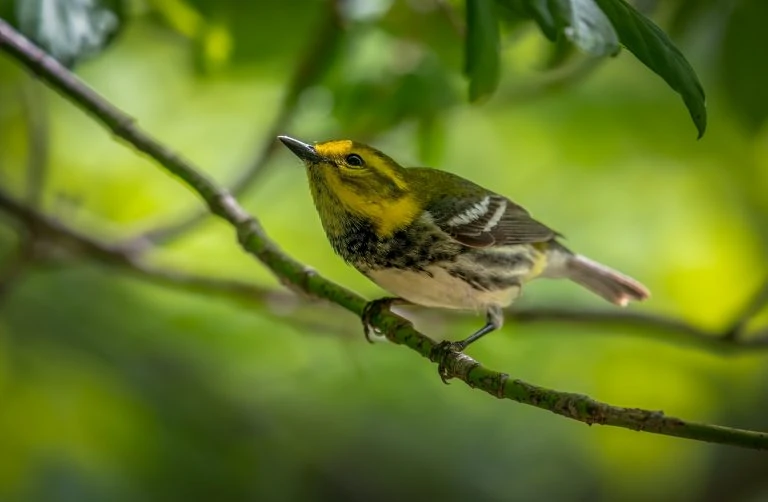
A small yellowish-green songbird with a yellow face and head and olive-yellow back. They have black streaking on the sides and wings and are whitish underneath.
- Length: 4.3-4.7 in (11-12 cm)
- Weight: 0.3-0.4 oz (7-11 g)
- Wingspan: 6.7-7.9 in (17-20 cm)
Black-throated Green Warblers can mostly be seen during their long migration over the Eastern US up to their breeding grounds in Northeastern US states and Canada.
They live high up in forests eating insects and their black throat is an easier way to tell them apart from other small yellow birds.
Orange-crowned Warblers
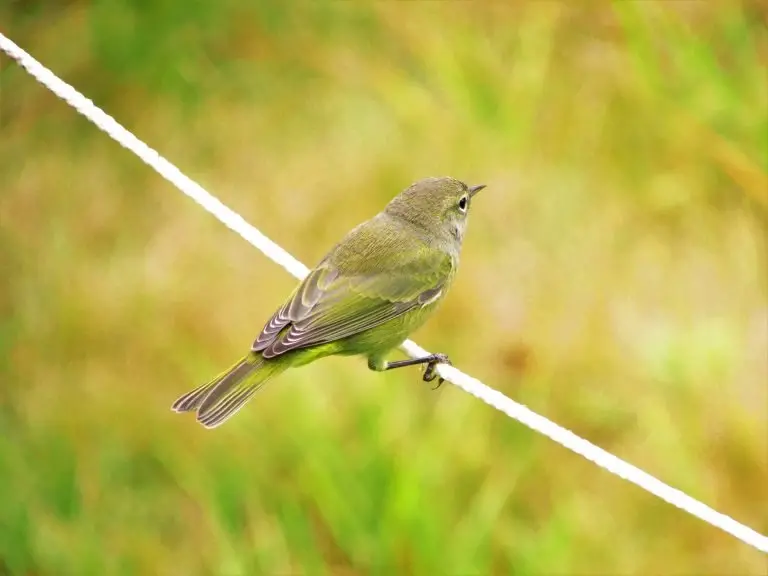
Orange-crowned Warblers are not as brightly colored as other warblers with their yellow-olive coloring, which is more yellow on the Pacific Coast. The orange crown is rarely seen.
- Length: 4.3-5.5 in (11-14 cm)
- Weight: 0.3-0.4 oz (7-11 g)
- Wingspan: 7.5 in (19 cm)
Breeding in Canada and western states before migrating to the Pacific, East and Gulf Coasts and Mexico. Orange-crowned Warblers can also be seen during migration across all states.
Arctic Warbler

A small olive-green and brown warbler that is only found in Alaska. Arctic Warblers have a distinctive whitish line just above the yes on each side of their heads.
- Length: 4.3-5.1 in (11-13 cm)
- Weight: 0.3 oz (10 g)
Arctic Warblers are originally from Eurasia but have now bred in Alaska before heading to Asia for the winter.
They feed on insects in wooded areas, usually near streams.
Kentucky Warbler
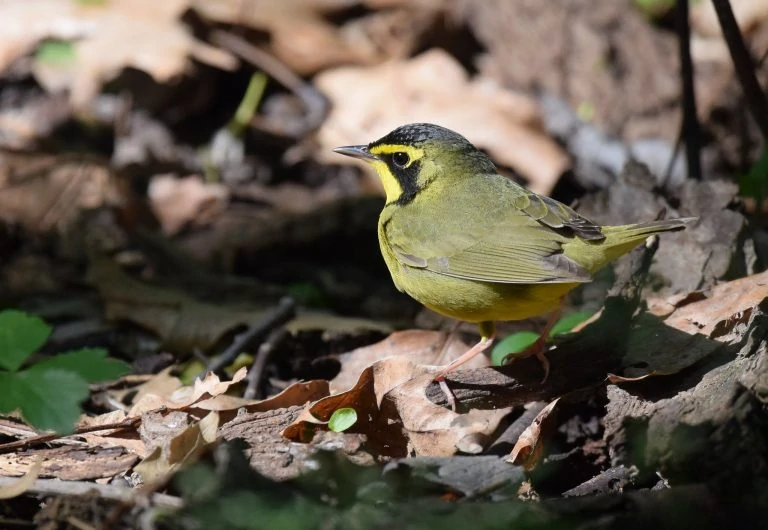
Credit: Andy Reago & Chrissy
Kentucky Warblers are olive-green on the back and yellow underneath. Males have black markings on their faces and black crowns.
Kentucky Warblers breed in eastern US states and spend the winter in Mexico and Central America.
- Length: 5.1 in (13 cm)
- Weight: 0.5-0.5 oz (13-14 g)
- Wingspan: 7.9-8.7 in (20-22 cm)
You can find Kentucky Warblers in deciduous woodland on the ground so they can be easier to spot. Nests of Kentucky Warblers are also unusually on the ground.
Yellow Warbler Female
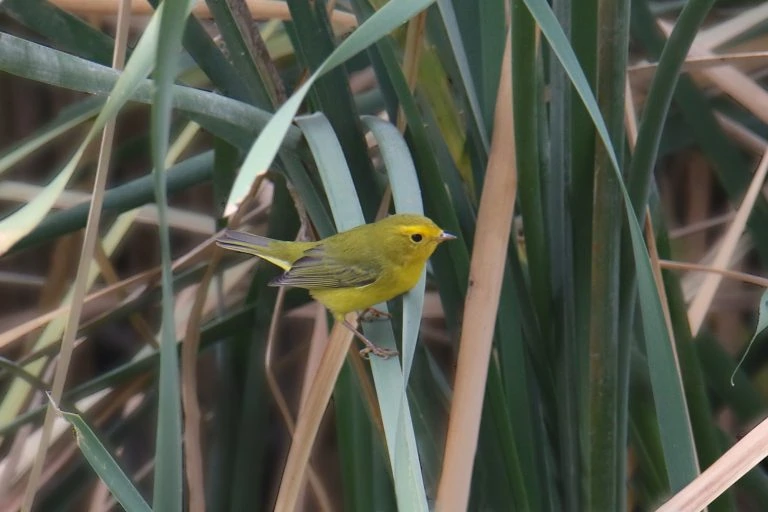
Yellow Warblers females have a yellow-green back and are not as bright as the males. Males are brighter yellow but also have greenish-yellow backs and they have chestnut streaks on the breast. They have grayish streaks on the wings.
- Length: 4.7-5.1 in (12-13 cm)
- Weight: 0.3-0.4 oz (9-11 g)
- Wingspan: 6.3-7.9 in (16-20 cm)
Yellow Warblers migrate a long distance to breed over much of North America before heading into Central and northern South America for winter.
They can be seen during migration in the far south.
Yellow Warblers can be found along streams and wetlands in thickets and along the edges of fields foraging for insects, including caterpillars, midges, beetles, bugs, and wasps.
Warblers are hard to attract to your backyard as they are shy and eat mainly insects, but you can try suet, oranges, and peanut butter.
Wilson’s Warbler Female
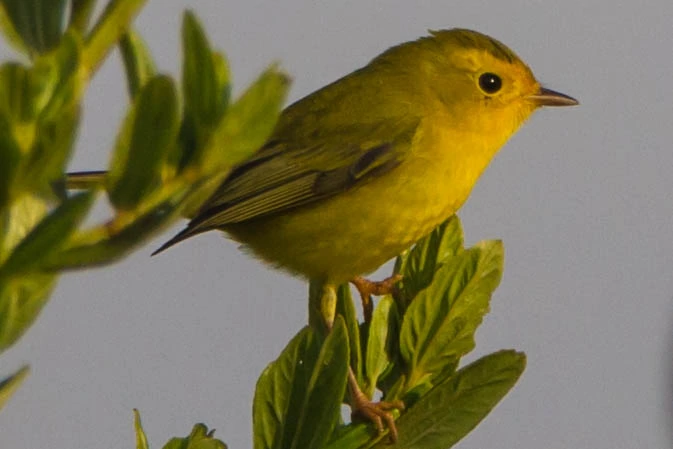
Credit: Dawn Beattie
Wilson’s Warblers are small yellow warblers with a black cap in the males and an olive cap in females. Female Wilson’s Warblers have olive-green backs and are yellow underneath.
- Length: 3.9-4.7 in (10-12 cm)
- Weight: 0.2-0.3 oz (5-10 g)
- Wingspan: 5.5-6.7 in (14-17 cm)
Breeding in Canada, Alaska and northwestern states, Wilson’s Warblers can also be seen across all states during migration. They winter in Mexico and Central America.
To find Wilson’s Warblers look along streams in thickets.
Hooded Warbler Female
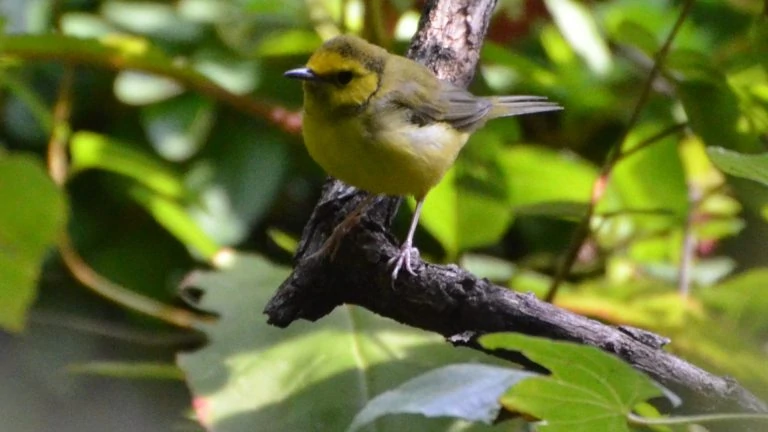
Credit: Andy Reago & Chrissy
Female Hooded Warblers are olive-green on the back and greenish-yellow on their bellies. They sometimes have slightly darker hood outline markings.
Male Hooded Warblers have a bright yellow face with a distinctive black hood and throat. They are yellow underneath and olive-green above.
- Length: 5.1 in (13 cm)
- Weight: 0.3-0.4 oz (9-12 g)
- Wingspan: 6.9 in (17.5 cm)
They breed in eastern states before heading south into Central America and the Caribbean for winter.
Forests with dense understories to hunt for insects are the best place to find Hooded Warblers.
Ruby-crowned Kinglet

Ruby-crowned Kinglets are small songbirds that are olive-green and the males have a brilliant red crown that is usually flat so hard to see, but really great if you do.
- Length: 3.5-4.3 in (9-11 cm)
- Weight: 0.2-0.3 oz (5-10 g)
- Wingspan: 6.3-7.1 in (16-18 cm)
Ruby-crowned Kinglets breed across Canada and the Western mountains before migrating to southern and southwestern states and Mexico for the winter.
They can also be seen during migration when they are widespread.
Ruby-crowned Kinglets can be hard to spot and they are fast-moving quiet birds that flit around in the foliage of lower branches and of shrubs and trees looking for spiders and insects.
They come to suet feeders or platform feeders for hulled sunflower seeds, peanut hearts, and mealworms.
Golden-crowned Kinglet
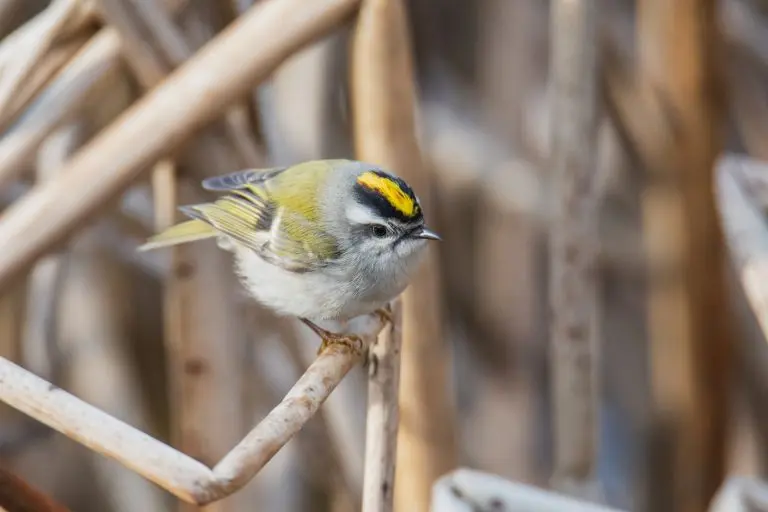
Golden-crowned Kinglets are tiny birds with green backs, a black-and-white striped face and an orange-yellow crown patch. Males and females look the same.
- Length: 3.1-4.3 in (8-11 cm)
- Weight: 0.1-0.3 oz (4-8 g)
- Wingspan: 5.5-7.1 in (14-18 cm)
Golden-crowned Kinglets can be found in all US states in winter. In summer some breed in Canada before moving to the coast or further south for winter. Golden-crowned Kinglets in the mountains of the west tend to stay all year.
You can find Golden-crowned Kinglets in forests, woodland and parks and sometimes backyards. They tend to be high up in the canopy so they can be hard to spot. They eat mainly insects so they do not usually visit backyard feeders.
Red-eyed Vireo
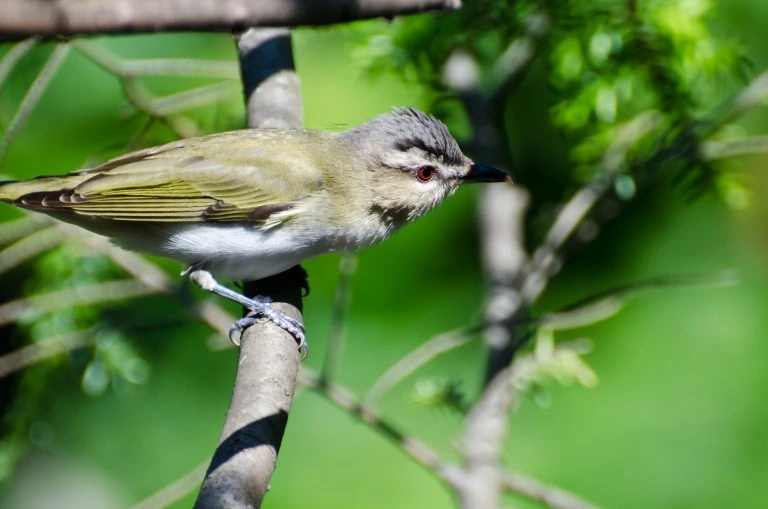
Red-eyed Vireos are olive-green on their backs and white below. They have gray crowns and a white stripe above the eye. Their red eyes may appear dark from a distance or in some light conditions.
- Length: 4.7-5.1 in (12-13 cm)
- Weight: 0.4-0.9 oz (12-26 g)
- Wingspan: 9.1-9.8 in (23-25 cm)
Red-eyed Vireos spend their summer breeding over much of Canada and the United States, except Alaska, the far north of Canada, and the Southwestern States. They spend winter in South America.
They are common in forests during the summer but often remain high up in the canopy.
White-eyed Vireo
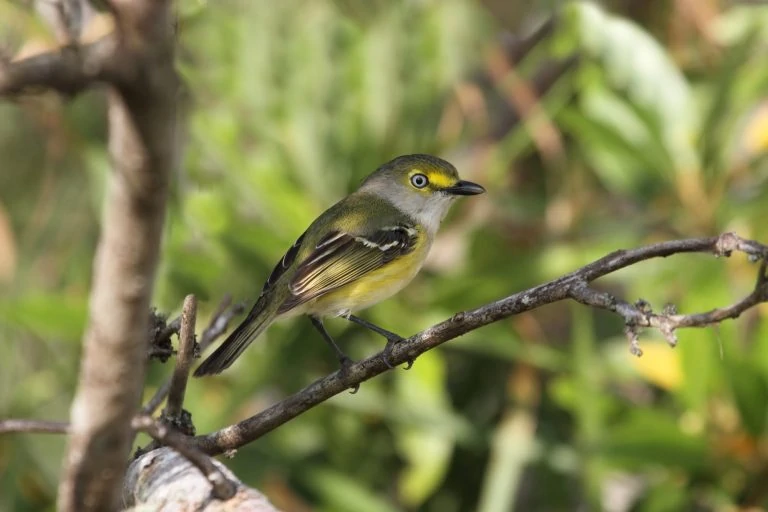
A small songbird in gray and yellow tones. White-eyed Vireos have a gray head, white chest and throat and yellow sides with darker wings and two white wingbars with black streaking.
They have yellow across the eyes and forehead and a white eye.
- Length: 4.3-5.1 in (11-13 cm)
- Weight: 0.3-0.5 oz (10-14 g)
- Wingspan: 6.7 in (17 cm)
Spending the summer across the southeastern United States, hidden in thickets out of sight. They winter along the southeastern coast, Mexico and the Caribbean.
White-eyed Vireos feed on insects, flies and spiders found in overgrown pastures and brambles.
The best bird feeder to attract small birds without bully birds such as grackles eating all the seed is this Woodlink caged feeder as the cage is far enough away from the feeder to prevent bigger birds just putting their heads through.
Check out these articles if you want to know more about birds in North America:
- Backyard Birds in Every State – Free Picture ID Printable
- Hummingbirds in North America
- Birds with Red Heads
Violet-green Swallow
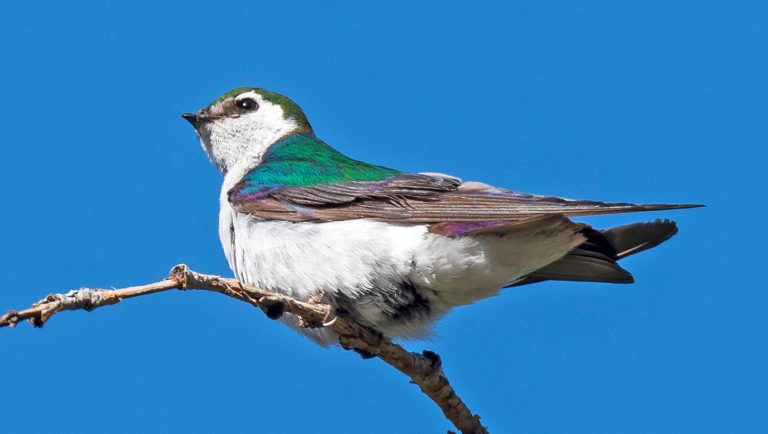
If you see a flash of bright white against a dark green and bronze back, then you know a Violet-green Swallow has just flown past. Their lower back and along the wings are an iridescent violet color that catches the light.
- Length: 4.7 in (12 cm)
- Weight: 0.5 oz (14 g)
- Wingspan: 10.6 in (27 cm)
Violet-green Swallows breed in western US states and through Canada to Alaska. They spend the winter in Mexico and Central America.
They can be found near open woodlands by ponds, rivers and lakes, especially in the early morning.
Green Jay
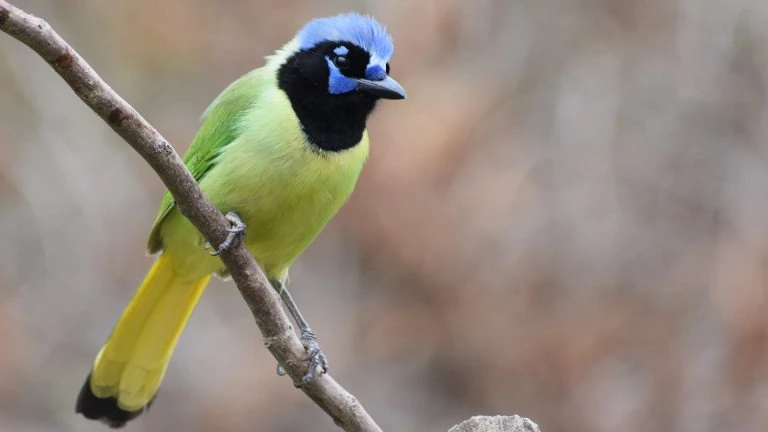
This colorful Green Jay is a rare find in the US as they are only seen in southern Texas.
They have dark green backs, paler bellies and bright blue and black heads.
- Length: 11.4 in (29 cm)
- Weight: 2.3-3.9 oz (66-110 g)
Green Jays live along the coasts of Mexico and in Central America. They are also found in southeastern Texas.
They can be found in woodlands near streams and water and feed on insects and seeds. If you are lucky you may see one at bird feeders in Texan wildlife refuges.
Green Heron

Green Herons are small colorful birds with deep green backs and reddish throats. They can look more grey in low lighting.
- Length: 16.1-18.1 in (41-46 cm)
- Weight: 8.5 oz (240 g)
- Wingspan: 25.2-26.8 in (64-68 cm)
Green Herons breed predominantly in eastern US states in swamps and marshes, but some also breed along the coast in the northwest. In winter they fly southern coasts, Mexico and Central America. Some Green Herons remain all year in the south in California, Florida and the Gulf Coast.
They can often be seen waiting at the water’s edges for small fish.
Green-tailed Towhee
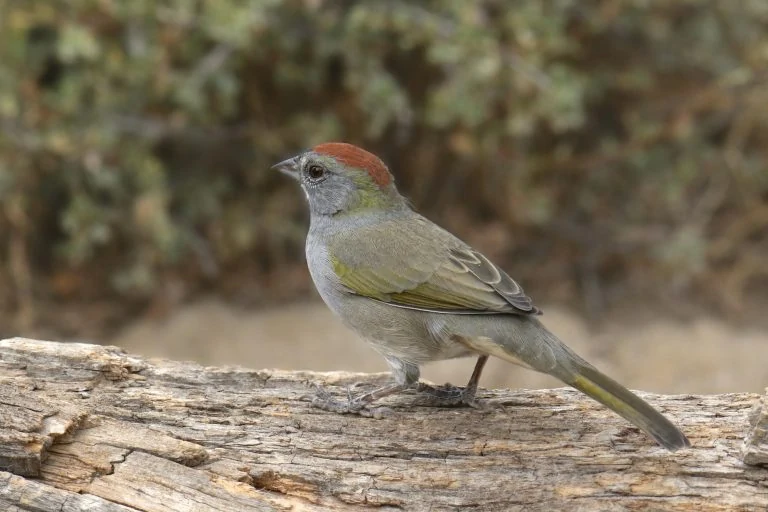
Green-tailed Towhees are chunk birds with long green tails. They are grayish birds with greenish wings, back and tails. They have a bright reddish crown.
Green-tailed Towhees breed in the western US states inland and spend the winter in southwestern US states and Mexico.
They can be found foraging on the ground, often hidden in shrubs, looking for seeds and small insects.
Green Kingfisher
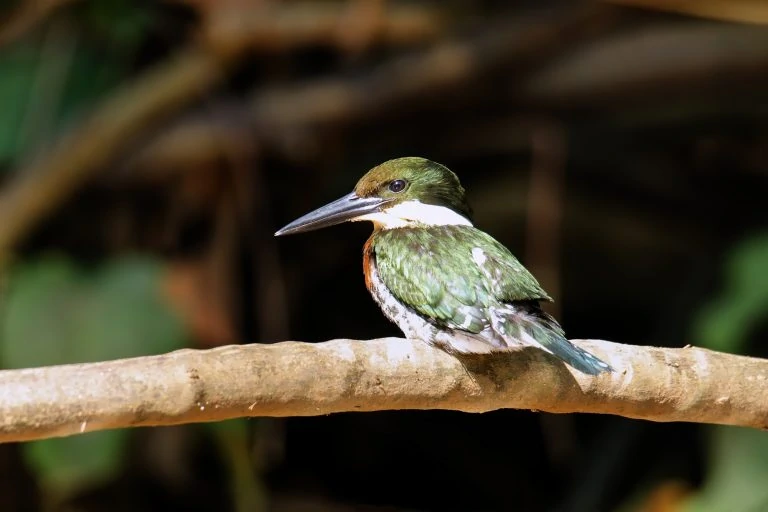
Green Kingfishers live along the Mexican border by streams and rivers. They can be seen perched on low overhanging branches waiting for small fish to swim by.
Green Kingfishers are quite hard to spot as they are small and stay very still.
Green Parakeet
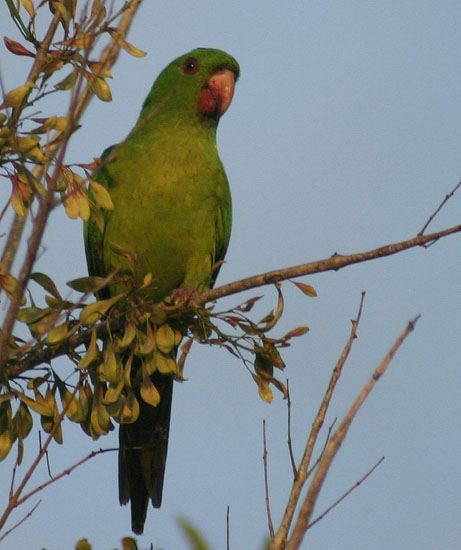
Credit: Michael Woodruff
Green Parakeets are usually living in Mexico and Central America but escaped pet birds and an expanding northerly range means these bright green birds are now found in Texas and occasionally in other warm states.
Monk Parakeet
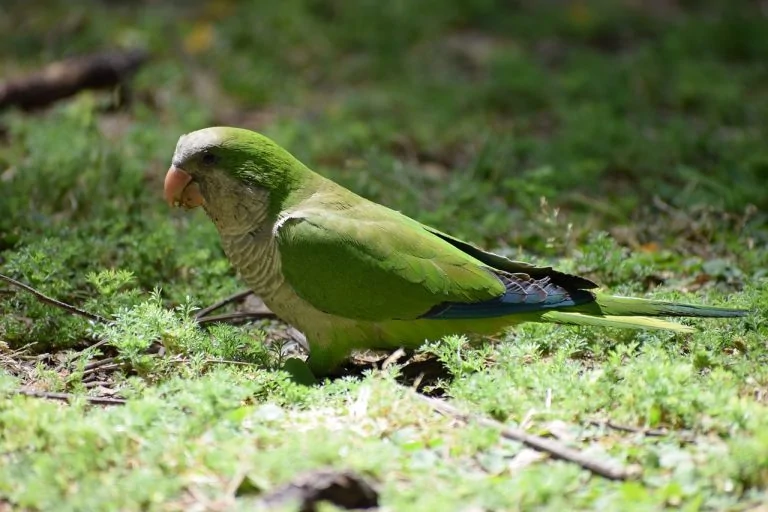
A small bright green parakeet with gray faces and breasts. They also have blue along the flight feathers. Monk Parakeets are only about the size of a European Starling.
- Length: 17.7-20.9 in (45-53 cm)
- Weight: 3.2-4.2 oz (90-120 g)
Monk Parakeets usually live in South America but they are now living in many southern US cities. Some have even started living as far north as New York. They are adaptable birds that can feed on fruit trees in orchards and gardens.
Nanday Parakeet
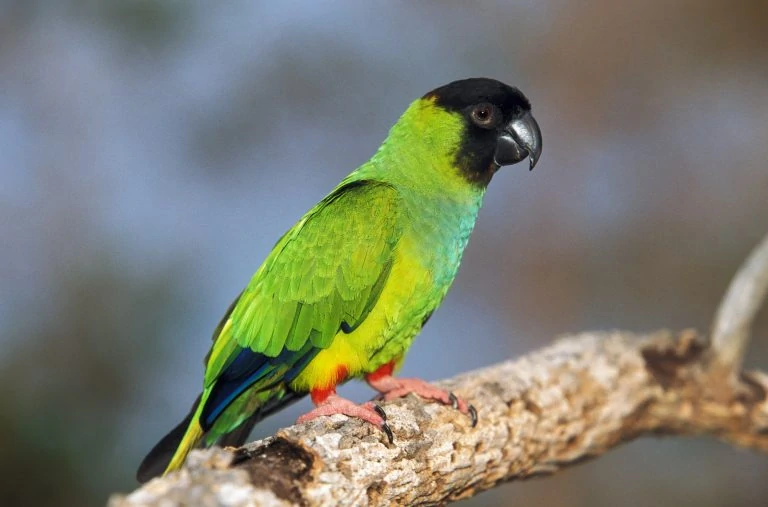
Another escaped popular pet bird, the Nanday Parakeet is a bright green bird with black heads. They were previously called the Black-hooded Parakeet.
They can now be found in Los Angeles, Florida and Arizona.
Lewis’s Woodpecker
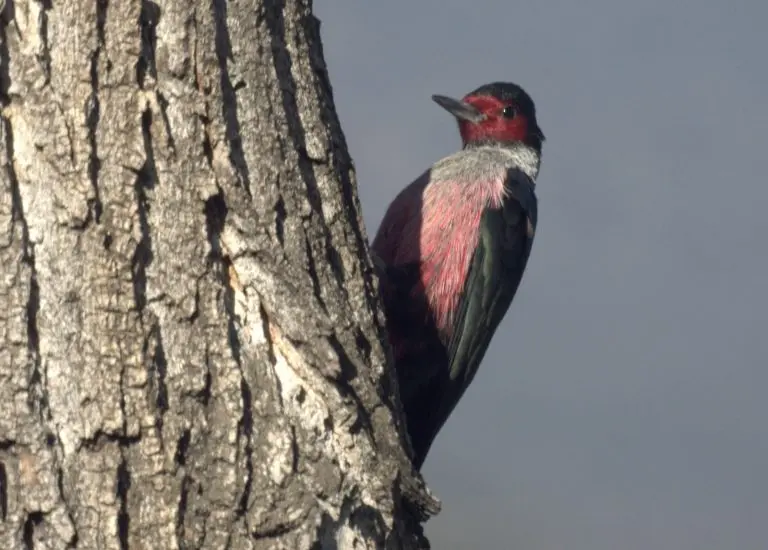
Credit: Mike Bird
Lewis’s Woodpeckers look like a completely different bird species, catching insects on the wing rather than hammering on trees. Then there is the pink belly, gray collar, and dark greenish back with a dark red face to set it apart from its family.
- Length: 10.2-11.0 in (26-28 cm)
- Weight: 3.1-4.9 oz (88-138 g)
- Wingspan: 19.3-20.5 in (49-52 cm)
Lewis Woodpeckers can be found from as far north as British Columbia and down to California and Texas. They tend to breed further north in British Columbia, east to Wyoming, and south to Nevada. This woodpecker migrates south to southwestern states. Those on the Pacific Coast tend to remain all year as do those in the southeast of their range.
As well as eating flying insects, Acorn Woodpeckers also eat nuts and fruit and they will store them in crevices of cottonwood trees in winter.
Lewis’s Woodpeckers do not make their own nests, preferring instead to us those created by other woodpeckers and they lay 5 – 9 eggs.
Where to Spot Lewis’s Woodpeckers:
They are usually easier to spot in the breeding season in pine forests darting through the air to catch insects.
How to Attract Lewis Woodpeckers to your backyard:
As they are rare they are not usually spotted.
Find out more about woodpeckers in North America:
Allen’s Hummingbird
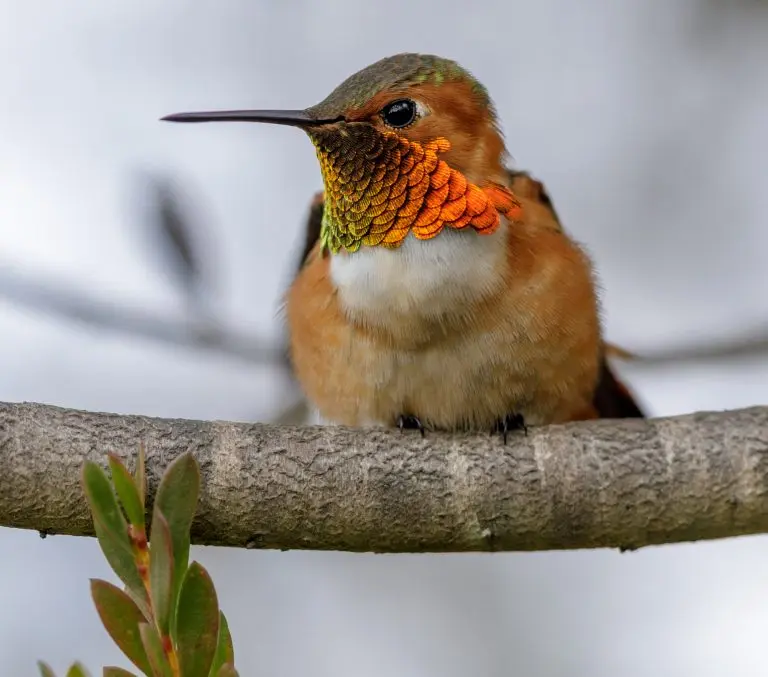
Allen’s Hummingbirds look very similar to Rufous Hummingbirds so it’s hard to tell them apart in the narrow band of coastal forest and scrub they inhabit between California and Oregon.
Male Allen’s Hummingbirds have iridescent reddish-orange throats and orange bellies, tails, and eye patches. Both males and females have long straight bills and coppery-green backs but the females lack the bright throat coloring.
- Length: 3.5 in (9 cm)
- Weight: 0.1-0.1 oz (2-4 g)
- Wingspan: 4.3 in (11 cm)
The difference between Allen’s and Rufous Hummingbirds is the narrow outer tail feathers in Allen’s Hummingbird. They build nests at no fixed height near shady streams and have up to 3 broods a year.
Allen’s Hummingbirds spend winter in Mexico and migrate as early as January up to the Pacific Coast in California and Oregon but they are most common between March and July. Some remain residents in central Mexico and around Los Angeles.
Black-chinned Hummingbird
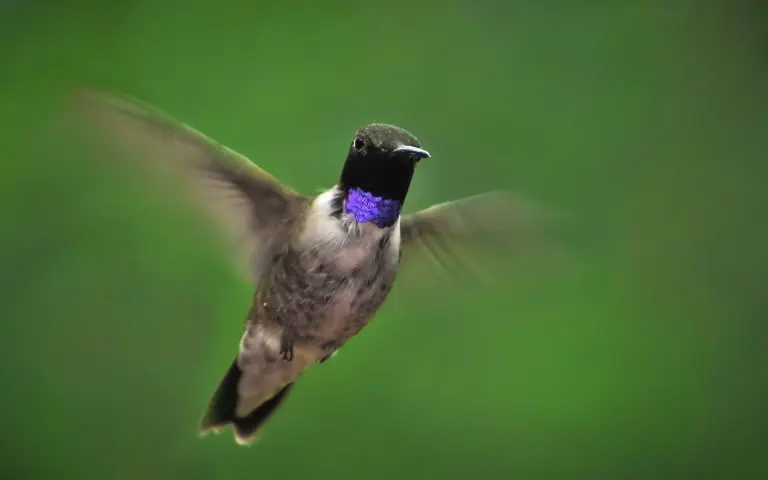
Black-chinned Hummingbirds are dull metallic green on the back and grayish-white underneath. The males have a black throat with a thin iridescent purple base and the females have a pale throat and white tips on the tail feathers.
- Length: 3.5 in (9 cm)
- Weight: 0.1-0.2 oz (2.3-4.9 g)
- Wingspan: 4.3 in (11 cm)
Black-chinned Hummingbirds breed predominantly inland in western states from British Columbia to Baja California in summer. After breeding, they may move to higher mountain areas with abundant flowers before migrating to western Mexico, southern California, and the Gulf Coast in the winter. Migration of Black-chinned Hummingbirds usually occurs in March and September
They eat nectar, small insects, and spiders and their tongues can lick 13-17 times per second when feeding on nectar. Nests of Black-chinned Hummingbirds are made of plant down and spider silk to hold it together and they lay 2 white tiny eggs that are only 0.6 in (1.3 cm)
Black-chinned Hummingbirds can often be seen sitting at the top of dead trees on tiny bare branches and often return to a favorite perch. They can be found along canyons and rivers or by shady oaks.
Blue-throated Mountain Gem
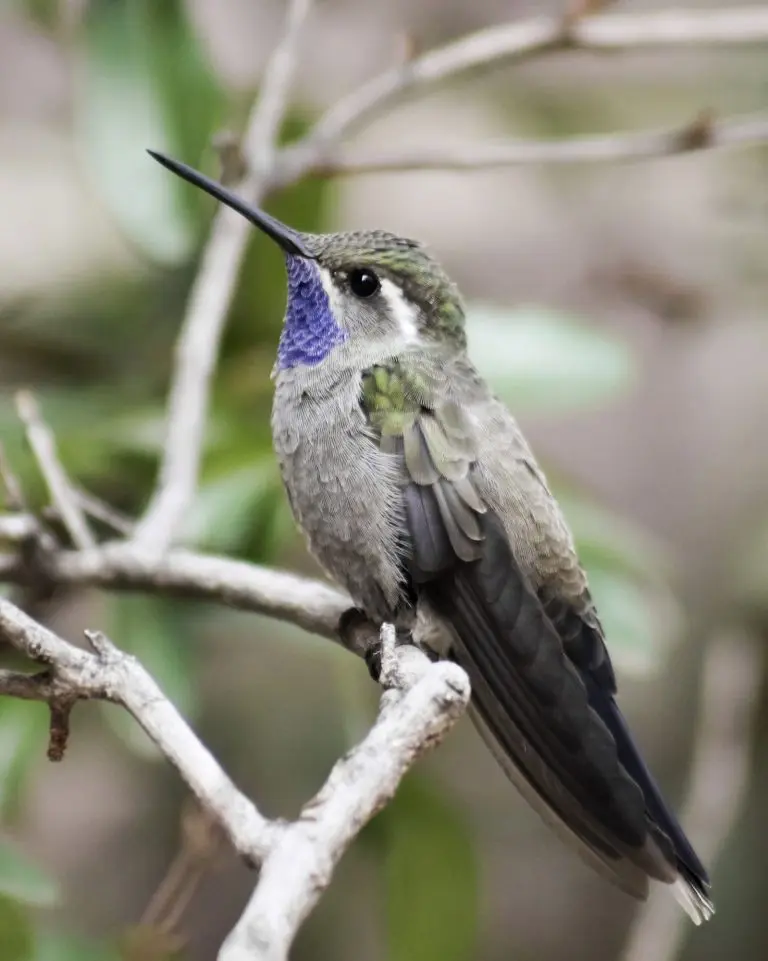
The Blue-throated Mountain-gem is the largest hummingbird that nest in the United States and as the name suggests the males have iridescent blue throats. Both male and female Blue-throated Mountain gems are bronzy-green on the back and grayish below, with white tips on the black tail feathers.
- Length: 4.3-4.7 in (11-12 cm)
- Weight: 0.3-0.3 oz (8.1-8.6 g)
Mostly resident in Mexico but some Blue-throated Mountain gems move north short distances into southeastern Arizona and southwestern Texas. Mountain woodlands along streams with lots of flowers or backyards with feeders are the best places to spot Blue-throated Mountain gems. They feed more in the morning and late afternoon, out of the heat of midday.
Nests of Blue-throated Mountain gems are larger than most to accommodate their larger size and can measure 2 inches wide and 3 – 10 inches high.
Find out more about hummingbirds in North America:
Broad-billed Hummingbird
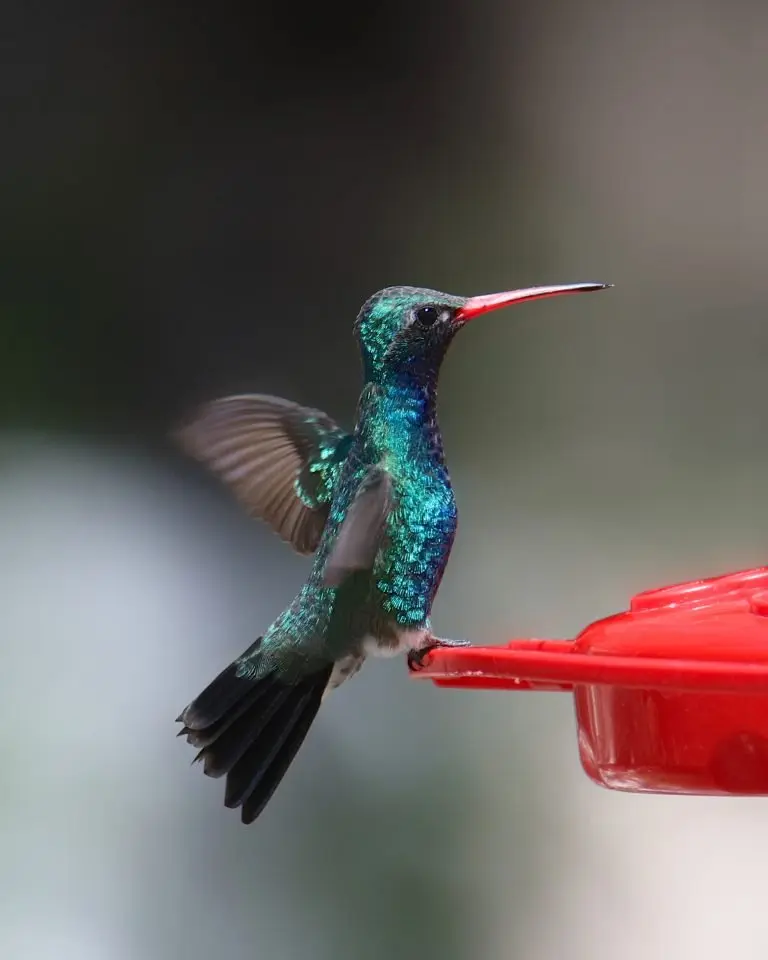
Broad-billed Hummingbirds are brilliantly colored, even among hummingbirds. The males are rich metallic green all over with a blue throat that extends down the breast. Females have a pale belly and both males and females have red beaks that are black-tipped and wide near their heads.
- Length: 3.1 – 3.9 in (8-10 cm)
- Weight: 0.1-0.1 oz (3-4 g)
Broad-billed Hummingbirds are resident all year in central Mexico and the Pacific Coast of Mexico. Some birds migrate north into mountain canyons in southern Arizona and New Mexico, for breeding between March and September and a few remain all year near the Mexican border.
Canyon streams and mountain meadows provide the ideal foraging areas for Broad-billed Hummingbirds but they will also visit backyard feeders. Nests are built quite low to the ground at about 3 feet near streams.
Broad-tailed Hummingbird
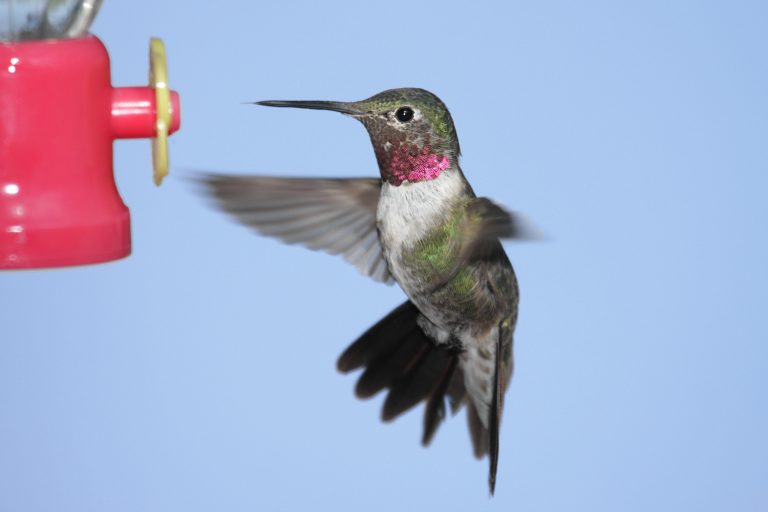
Broad-tailed Hummingbirds live in higher elevations and are iridescent green on the back, brownish in the wings, and white on the chest and into the belly. Males have an iridescent rose throat, females and juveniles have green spots on their throats and cheeks.
- Length: 3.1-3.5 in (8-9 cm)
- Weight: 0.1-0.2 oz (2.8-4.5 g)
Broad-tailed Hummingbirds breed in high meadows and open woodlands between 5,000 – 10,000 feet elevation in the mountainous west, between late May and August between central Idaho, southern Montana, northern Wyoming, and south to California
Migration south is to southern Mexico for winter but some Broad-tailed Hummingbirds may stay on the Gulf Coast. Migration of Broad-tailed Hummingbirds occurs in April and late-August and September
Due to the cold at higher elevations, the Broad-tailed Hummingbird can slow their heart rate and drop their body temperature to enter a state of torpor.
Nectar from flowers is the usual food of hummingbirds and Broad-tailed Hummingbirds drink from larkspur, red columbine, sage, scarlet gilia and they will also come to hummingbird nectar feeders. They supplement their diet with small insects and will feed their young on insects too.
Broad-tailed Hummingbird nests are usually on evergreen or aspen branches and are made with spider webs and gossamer under overhanging branches for added insulation during cold nights.
Calliope Hummingbird
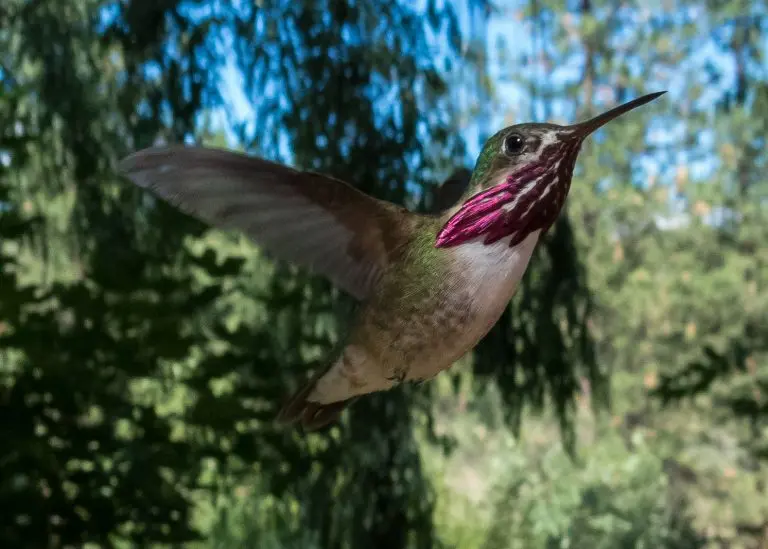
The tiny ping ball-sized Calliope Hummingbird is the smallest bird in the United States but still manages to fly more than 5000 miles each year all the way from Mexico up as far as Canada and back. They also punch above their weight when it comes to defending their territory and even chase Red-tailed Hawks.
Male Calliope Hummingbirds have bright magenta throats, (known as the gorget), glossy green backs and flanks, and a dark tail. Females lack the iridescent throats and are more pinkish-white underneath rather than white in the males.
- Length: 3.1-3.5 in (8-9 cm)3
- Weight: 0.1-0.1 oz (2.3-3.4 g)
- Wingspan: 4.1-4.3 in (10.5-11 cm)
Calliope Hummingbirds’ spring migration is to the Rocky Mountains along the Pacific Coast to breeding areas in California, Colorado, and up to northwestern states, Alberta, British Columbia, and Vancouver Island. They start migration relatively early in February to arrive from Mid-April to early May as far north as Canada.
Fall migration is by the Rocky Mountains to wintering grounds in southwestern Mexico, but also more recently to the Gulf Coast in late August and September.
Nests are usually on evergreen trees and they may reuse them or build on top of an old nest.
Costa’s Hummingbird
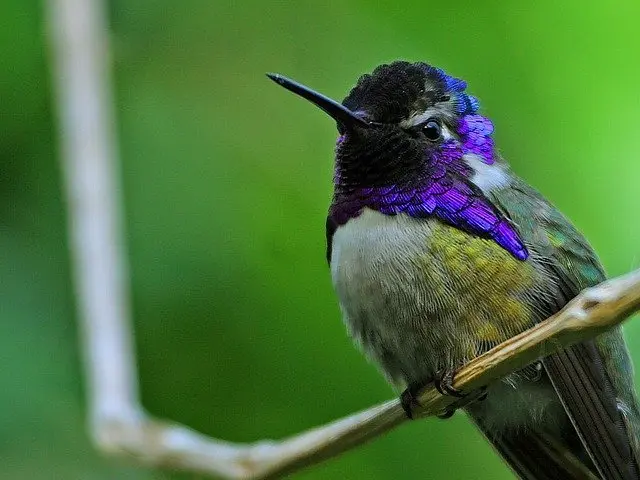
Costa’s Hummingbirds are predominantly desert hummingbirds with striking iridescent purple throat patches that flare out and a purple crown. Their backs are green and their bellies are white with green coloring on the sides. Female Costa’s Hummingbirds lack the purple color and are more white on the belly.
- Length: 3.5 in ( 7.6 – 8.8 cm)
- Weight: 0.1-0.1 oz (2-3 g)
Costa’s Hummingbirds are residents in Baja California and southern California and southwestern Arizona. They also migrate between the Pacific Coast of Mexico in winter and up into Arizona, the southern edges of Nevada and Utah, and California for breeding.
Desert scrub, chaparral, and deciduous forest provide the habitat of Costa’s Hummingbirds and they visit many different species of plants. Nests are built quite low at three to seven feet above the ground in shrubs and they may have up to two broods in a year.
Ruby-throated Hummingbird
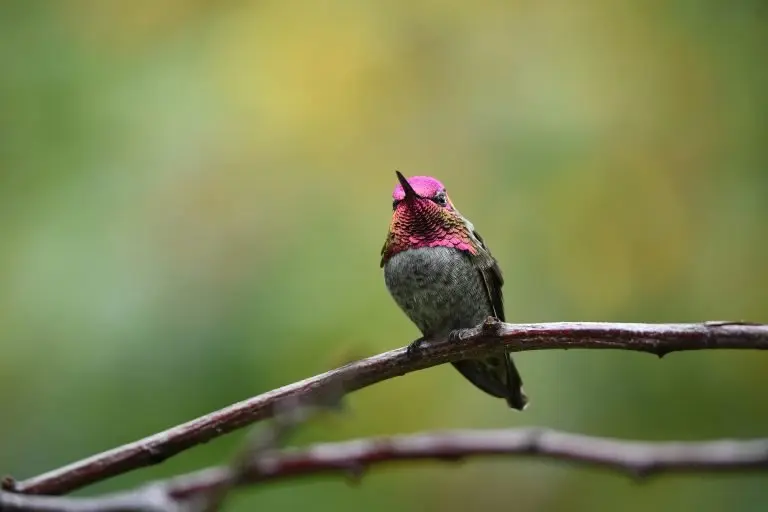
The Ruby-throated Hummingbirds are bright green on the back and crown, with a gray-white underside and the males have an iridescent red throat. Female Ruby-throated Hummingbirds are green on the back and white underneath with brownish crowns and sides.
- Length: 2.8-3.5 in (7-9 cm)
- Weight: 0.1-0.2 oz (2-6 g)
- Wingspan: 3.1-4.3 in (8-11 cm)
The Ruby-throated Hummingbird is the only breeding hummingbird in eastern North America, they then migrate further south to Central America for winter. Some migrate over the Gulf of Mexico or some migrate through Texas around the coast.
Ruby-throated hummingbirds start arriving in the United States in February and may not arrive in northern states and Canada until May for breeding. In Spring males usually arrive first up to one or two weeks before the females.
In the fall Ruby-throated Hummingbirds migrate south in August and September and gather in September along the Gulf Coast of Texas before making the final push south for winter.
These tiny birds zip from one nectar source to the next or catch insects in midair or from spider webs. They occasionally stop on a small twig but their legs are so short they cannot walk, only shuffle along a perch.
Flowering gardens or woodland edges in summer are the best places to find them when out. They are also common in towns, especially at nectar feeders.
Male Ruby-throated Hummingbirds can be aggressive in their defense of flowers and feeders. They do not stick around long after mating and may migrate by early August.
Ruby-throated females build nests on thin branches and make them out of thistle or dandelion down held together with spider silk. They lay 1-3 tiny eggs measuring only 0.6 in (1.3 cm)
Violet-crowned Hummingbird
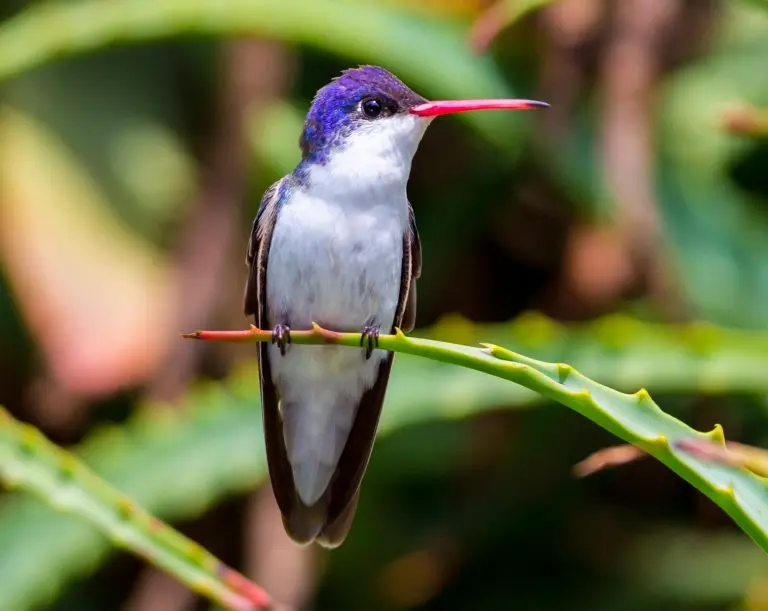
Violet-crowned Hummingbirds are medium-sized and have a violet cap as the name would suggest. They are dark olive-green on the back and white underneath. their beaks are red with a black tip. Females are less colorful than males. They have metallic bluish-green tails and a blue-black band across the tail near the end.
- Length: 4 in (10 cm)
- Weight: 0.18 oz (5 g)
Violet-crowned Hummingbirds range from the mountains in southeastern Arizona and southwestern New Mexico and down southwestern Mexico. They arrive in the United States in February or March and nest in Arizona and New Mexico between April and September. They generally move south for winter but some may remain at backyard feeders through the winter.
Habitat is tropical deciduous forests and semiarid scrub and nests are often in sycamore or oak trees.
Berylline Hummingbird
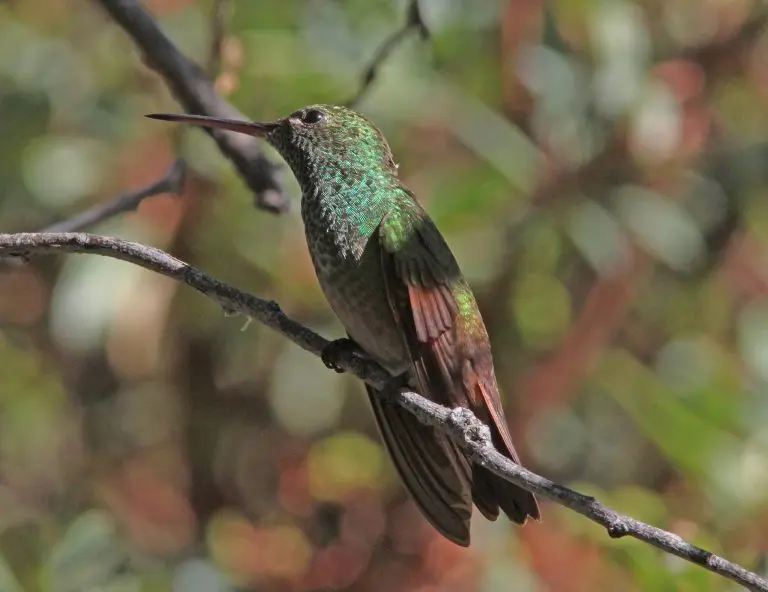
Berylline Hummingbird (credit: ALAN SCHMIERER)
Berylline Hummingbirds are metallic green with a gray lower belly and reddish in the wings. Females are less colorful than males and are slightly smaller. Their upper bills are black and the lower bill is reddish-orange.
- Length: 3 – 4.25 in (8-11 cm)
- Weight: 0.14 – 0.18 oz (4-5 g)
They range from Mexico to Honduras in open woodlands of oak and pine and shady canyons and they will also stray up into southeastern Arizona. They are usually solitary birds and can be aggressive in defending their territory including at hummingbird feeders.
The only place in North America that Berylline Hummingbirds can be found is in southeastern Arizona in the Santa Rita Mountains, Huachuca Mountains, and Chiricahua Mountains during breeding between April and November.
Mexican Violetear
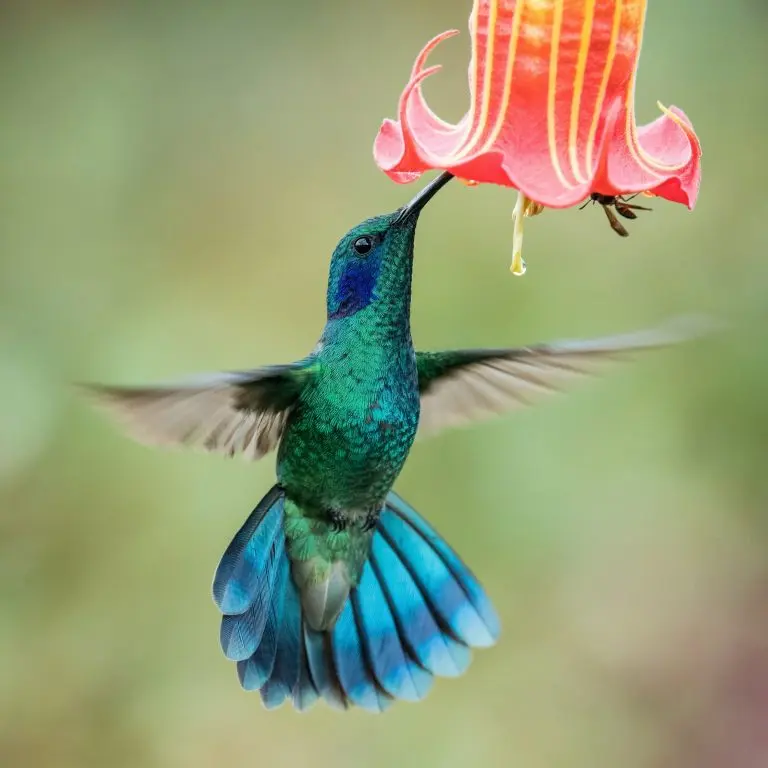
Mexican Violetears are medium-sized hummingbirds that are metallic green with violet patches on the sides of their heads and breasts.
- Length: 3.8 – 4.7 in (9.7 – 12 cm)
- Weight: 0.17 – 0.2 oz (4.8 – 5.6 g)
Mexican Violetears breed in forests in Mexico and through Central America to Nicaragua but can be found as far south as the mountains in Bolivia and Venezuela. Some non-breeding Mexican Violetears may fly north into the United States to central and southern Texas.
Green-breasted Mango
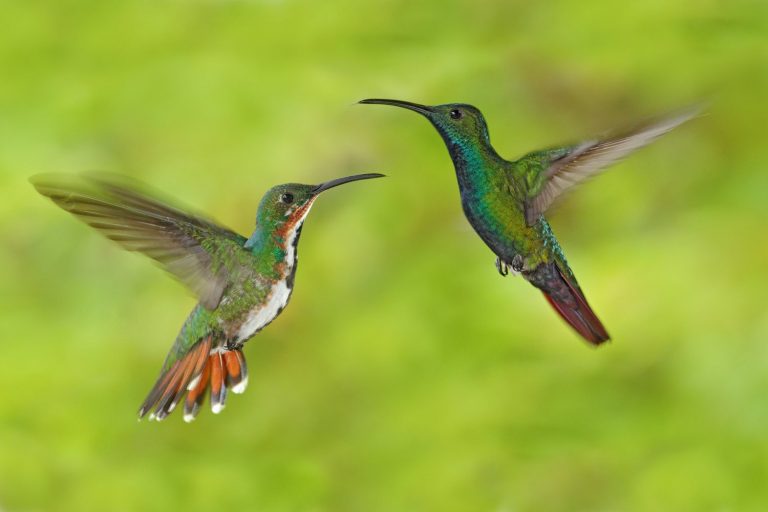
Green-breasted mangoes are glossy bright green on the back and the males have a blackish throat bordered with blue on the chest. Females are white underneath with a black stripe in the middle with a few bluish-green metallic feathers.
- Length: 4.3 – 4.7 in ( 11 – 12 cm)
- Weight: 0.24-0.25 oz (6.8 – 7.2 g)
Green-breasted Mangos are found near the coasts of Mexico and Central America and some down to northern South America. Their habitat is tropical deciduous forests, gardens, and some open or lightly wooded areas.
The Green-breasted Mango is very rare in North America but a few have been sighted in Texas on the southeastern border with Mexico.
Plain-capped Starthroat
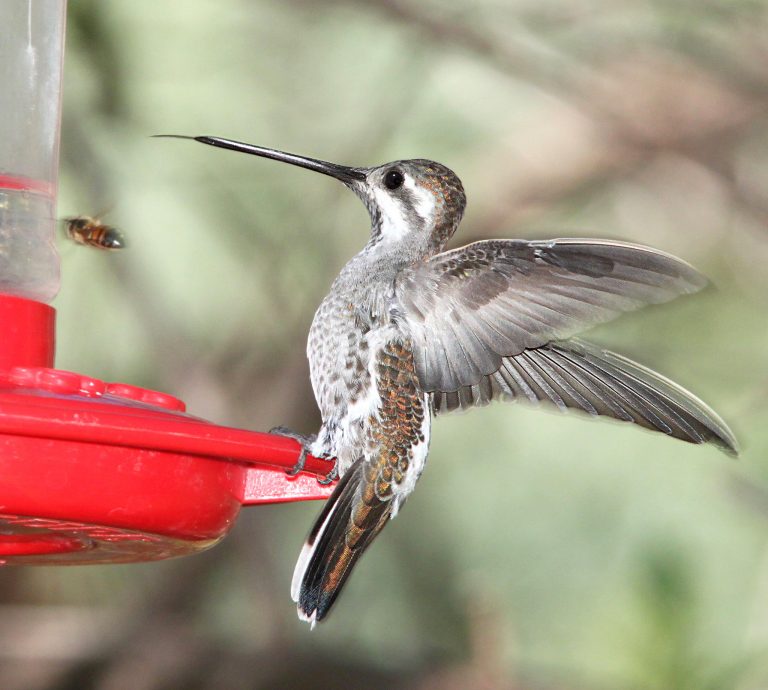
Plain-capped Starthroat (credit: ALAN SCHMIERER)
The Plain-capped Starthroat is large but quite dull in comparison to most hummingbirds with only a small violet-red throat patch that is hard to see as it looks dark in most like. They are also a metallic bronze color rather than the green of most hummingbirds. they have a white patch on the rump and the breast and belly are grayish-white. Females are less colorful than males.
- Length: 4.33 – 4.72 in (11 – 12 cm)
- Weight: 0.24 – 0.28 oz (7 – 8 g)
Arid or semiarid forests and streams along dry forest edges are the usual habitats of Plain-capped Starthroat between Mexico and Costa Rica. Although rare in North America, Plain-capped Starthroat can be seen at the end of the breeding season between June and September in southeastern Arizona at Miller Canyon and the Paton Center for Hummingbirds.
White-eared Hummingbird
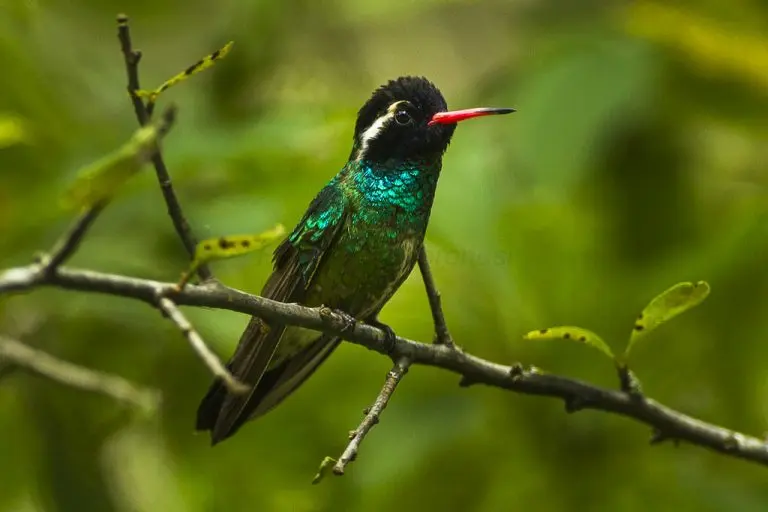
White-eared Hummingbird male (credit: Francesco Veronesi )
White-eared Hummingbirds are green on their backs and breasts with a black head and a white eyestripe on both males and females. Their beaks are red with a black tip. Males have a metallic turquoise green throat with violet patches on the face.
- Length: 3.5 – 4 in (9-10 cm)
- Weight: 0.1 – 0.14 oz (3-4 g)
White-eared Hummingbirds range from Nicaragua up to the mountains in southeastern Arizona, southwestern New Mexico, and western Texas but they are rare in the United States. They usually nest between March to August in northern and central Mexico or later in July in Arizona and they may have 3 broods in a year. They migrate to arrive in the southern United States in March and leave by early September.
Scrubby growth and forests or backyards provide the habitat of White-eared Hummingbirds and they nest in shrubs or low trees.
Rivoli’s Hummingbird
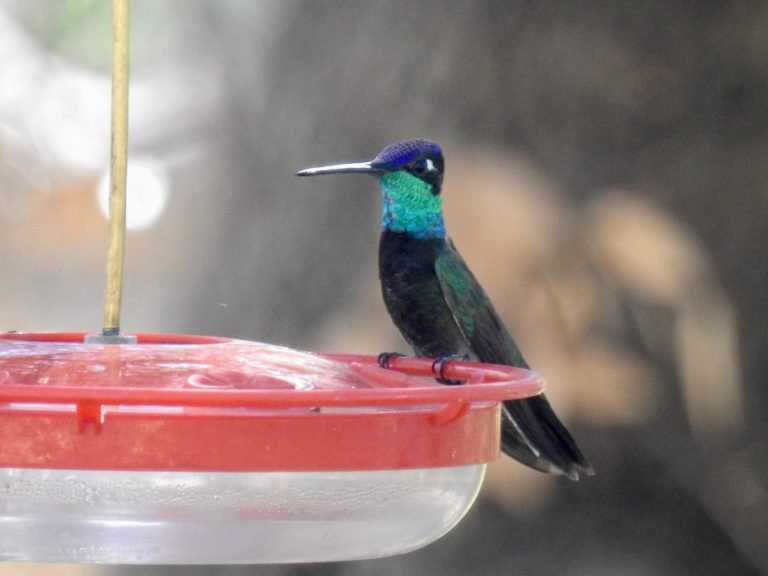
Rivoli’s Hummingbirds male and female (credit: Nate Steiner)
Rivoli’s Hummingbirds are large hummingbirds with more striking coloring than most hummingbirds as they have an iridescent purple crown as well as the more usual iridescent throat in the males, which is emerald green. Males are dark green and the females are green on the back and grayish underneath.
- Length: 4.3-5.5 in (11-14 cm)
- Weight: 0.3-0.3 oz (7-8 g)
Rivoli’s Hummingbirds are resident in Mexico and Central America but some do migrate north into southern Arizona and New Mexico and southwestern Texas. They can be found in pine-oak forests in mountainous regions but will visit feeders in their range. They build nests relatively high up.
Cinnamon Hummingbird
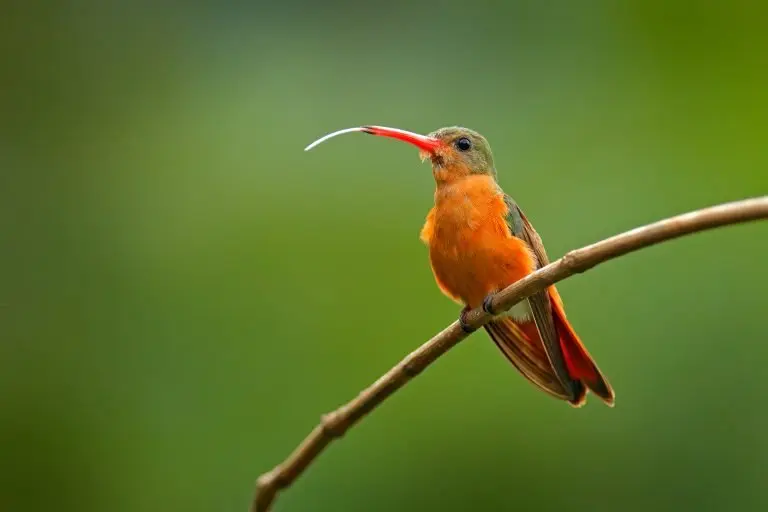
Cinnamon Hummingbirds are bronze-green on their backs and as their name suggests, they are cinnamon-colored underneath from under their chin to their tail. Their tails are reddish and their beaks have a black tip.
- Length: 3.9 in (10 cm)
- Weight: 0.18 oz (5 g)
Usually, Cinnamon Hummingbirds are found from northwestern Mexico down to Costa Rica but a few have ventured into the southwestern United States. They inhabit forest edges of pine and oak and also open scrubby areas, feeding on nectar and insects.

